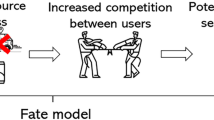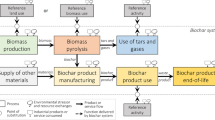Abstract
Goal, Scope and Background
The principal aim of this paper is to evaluate the environmental attributes and consequences of a ‘rehabilitation for residential redevelopment’ scenario. It is contrasted to a non-intensive and low-cost ‘exposure minimization’ scenario, assumed to be the default intervention option to obtain compliance. This paper also aims to (1) quantitatively evaluate the relative environmental significance of primary, secondary and tertiary impacts, and (2) to compare conclusions obtained from attributional and from consequential LCA of the same decision.
Main Features
An attributional LCA (ALCA) and a consequential LCA (CLCA) are used to compare the two radically different intervention options. The rehabilitation for residential redevelopment scenario involves ‘dig and dump’ remediation, infrastructure material recycling and site backfilling. The ‘exposure minimization’ scenario consists in covering the site with clean soil and subsequently idling the site. The functional unit allowing this comparison is the ‘legal and appropriate intervention on 1 ha of the tracked brownfield’. The inventory analyses are done following the proposals in Part 1. The LCIA is done using IMPACT 2002+ method.
Results and Conclusions
The ALCA results show no clear preference for either intervention option because of the trade-off between the benefits of decontamination and the impacts of the rehabilitation service system. The CLCA, on the other hand, unequivocally supports rehabilitation if it is followed by residential reuse, as long as the development of suburban sites is avoided. In these cases, tertiary environmental benefits dominate other types of impacts. It is concluded that, when brownfield intervention decisions can affect the fate of the site, the scope of brownfield management LCA should always be expanded to account for tertiary impacts.
Perspectives
The methodology proposed was restricted to a single site and to residential redevelopment. It is suggested that the general approach could be used for other types of brownfield redevelopments and for decisions affecting multiple brownfields.
Similar content being viewed by others
References
Alker S, Joy V, Roberts P, Smith N (2000): The definition of brownfield. Journal of Environmental Planning and Management 43(1) 49–69
Ferber U, Grimski D (2002): Brownfields and redevelopment of urban areas. Concerted Action ‘Contaminated Land Rehabilitation Network for Environmental Technologies’ (CLARINET)
Lesage P, Ekvall T, Deschênes L, Samson R (2007): Environmental Assessment of Brownfield Rehabilitation Using Two Different Life Cycle Inventory Models. Part 1: Methodological Approach. Int J LCA 12(6) 391–398
MENV (1998): Politique de protection des sols et de réhabilitation des terrains contaminés. Ministère de l’Environnement du Québec, Québec
QSAR (1997): Redéveloppement du site des ateliers angus à montréal: Analyse des risques pour la santé et plan de gestion des sols — rapport final. Chemin de Fer Canadien Pacifique, Montréal
QSAR (1998): Mise à jour du programme de réhabilitation des sols et évaluation complémentaire des impacts associés au développement de la zone commerciale — rapport final. Chemin de Fer Canadien Pacifique, Montréal
Quéformat (1998): Rapport de réhabilitation des cours angus. Chemin de Fer Canadien Pacifique, Montréal
Ekvall T, Weidema B P (2004): System boundaries and input data in consequential life cycle inventory analysis. Int J LCA 9(3) 161–171
Jolliet O, Margni M, Charles R, Humbert S, Payet J, Rebitzer G, Rosenbaum R (2003): Impact 2002+: A new life cycle impact assessment methodology. Int J Life Cycle Ass 8(6) 324–330
Toffoletto L, Deschênes L, Samson R (2005): Lca of ex-situ bioremediation of diesel-contaminated soil. Int J LCA 10(6) 406–416
European Environmental Agency (2000): Corine land cover. Commission of the European Communities OPOCE, Luxembourg
Kratsios J (2001): Personnal communication. L.A. Hébert, St-Constant, Qc.
Page CA, Diamond ML, Campbell M, McKenna S (1999): Life cycle framework for assessment of site remediation options: Case study. Environmental Toxicology and Chemistry 18(4) 801–810
Craighill A, Powell JC (1999): A lifecycle assessment and evaluation of construction and demolition waste. CSERGE Working Paper WM 99-03. Centre for Social and Economic Research on the Global Environment (CSERGE), London, UK
Balázs S, Antonini E, Tarantini M (2000): Application of life cycle assessment (lca) methodology for valorization of building demolition materials and products. In: Proceedings of the Environmentally Conscious Manufacturing Conference, 6–8 November 2000, Boston, Mass, USA
CRDIM (2002): État de la situation en environnement, orientation et interventions proposées. Rapport Technique. Conseil régional de développement de l’île de Montréal; Montréal
MAMM (2001): Cadre d’aménagement et orientations gouvernementales — Région métropolitaine de montréal 2001–2021. Ministère des Affaires Municipales et de la Métropole, Québec
Ville de Montréal (2004): Plan d’urbanisme de montréal. Partie i — les éléments pan-montréalais. Montréal: Ville de Montréal
Deason JP, Sherk GW, Carroll GA (2001): Public policies and private decisions affecting the redevelopment of brownfields: An analysis of critical factors, relative weights and areal differentials. The George Washington University, Washington DC, USA
Statistics Canada (1997): 1996 census of population. Profile of marital status, common-law status, families, dwellings and households, for canada, provinces, territories, census divisions and census subdivisions. Ottawa, Canada
Statistics Canada (2002): 2001 census of population. Profile of marital status, common-law status, families, dwellings and households, for canada, provinces, territories, census divisions and census subdivisions. Ottawa, Canada
Office of Energy Efficiency (2004): Comprehensive energy use database. Residential sector — Quebec. 〈http://oee.nrcan.gc.ca/Neud/dpa/trends_res_qc.cfm〉
[Anon] (1999): Mobilité des personnes dans la région de montréal. Enquête origine-destination. Traitement: Pascal lesage. Agence métropolitaine de transport, la Société de transport de la Communauté urbaine de Montréal, Société de transport de la Rive-Sud de Montréal, Société de transport de la Ville de Laval, Montréal
Hydro-Québec (2004): Plan statégique 2004–2008. Québec, Québec
Gourvil L, Joubert F (2004): Évaluation de la congestion routière dans la région de Montréal. Ministère des Transports du Québec, Québec
Tremblay P (2002): Survol technique du modèle de transport de la région de Montréal. Service de la modélisation des systèmes de transports, Ministère des Transports du Québec, Québec
Nay-Sour V (2004): Personal communication. Ministère des Transports du Québec, Québec
US EPA (2002): Nonroad model (nonroad engines, equipment and vehicles) 〈http://www.epa.gov/otaq/nonrdmdl.htm〉
EEA (2001): EMEP/Corinair emission inventory guidebook — 3rd edition, technical report no 30, group 8: Other mobile sources and machinery. 〈http://reports.eea.eu.int/technical_report_2001_3/en〉
Althaus H-J, Chudacoff M, Hischier R, Jungbluth N, Osses M, Primas A (2003): Life cycle inventories of chemicals. Final report ecoinvent 2000. Volume 8, Swiss Centre for LCI, EMPA-DU, Dübendorf, Switzerland
Kellenberger D, Althaus H-J, Jungbluth N, Künniger T (2003): Life cycle inventories of building products. Final report ecoinvent 2000, Volume 7, Swiss Centre for LCI, EMPA-DU, Dübendorf, Switzerland
Spielmann M, Kägi T, Stadler P, Tietje O (2004): Life cycle inventories of transport services. ecoinvent report no. 14, Swiss Centre for Life Cycle Inventories, Dübendorf, Switzerland
Doka G (2003): Life cycle inventories of waste treatment services. Final report ecoinvent 2000, Volume 13, Swiss Centre for LCI, EMPA-SG, Dübendorf, Switzerland
Jungbluth N (2003): Erdöl. Sachbilanzen von Energiesystemen. Final report no. 6, ecoinvent 2000, Swiss Centre for LCI, PSI, Dübendorf and Villigen, Switzerland
Dones R, Bauer C, Bolliger R, Burger B, Faist Emmenegger M, Frischknecht R, Heck T, Jungbluth N, Röder A (2003): Sachbilanzen von Energiesystemen. Final report ecoinvent 2000, Volume 6, Swiss Centre for LCI, PSI, Dübendorf and Villingen, Switzerland
Bolliger R (2003): Wasserkraft. Sachbilanzen von Energiesysystemen. Final report no. 6, ecoinvent 2000, Volume 6, Swiss Centre for LCI, PSI, Dübendorf and Villigen, Switzerland.
Humbert S, Margni M, Jolliet O (2004): Impact 2002+: User guide (draft for version 2.0). Industrial Ecology & Life Cycle Systems Group, GECOS, Lausanne, Switzerland.
Faist Emmenegger M, Heck T, Jungbluth N (2003): Erdgas. Sachbilanzen von Energiesystemen. Final report no. 6, ecoinvent 2000, Swiss Centre for LCI, PSI, Dübendorf and Villigen, Switzerland
Author information
Authors and Affiliations
Corresponding author
Rights and permissions
About this article
Cite this article
Lesage, P., Ekvall, T., Deschênes, L. et al. Environmental assessment of brownfield rehabilitation using two different life cycle inventory models. Int J Life Cycle Assess 12, 497–513 (2007). https://doi.org/10.1065/lca2006.10.279.2
Received:
Accepted:
Published:
Issue Date:
DOI: https://doi.org/10.1065/lca2006.10.279.2




